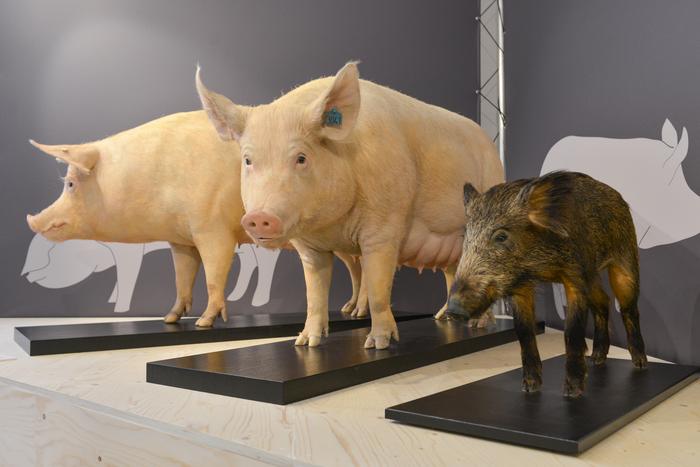
In a transformative study, researchers from Martin Luther University Halle-Wittenberg have unveiled significant evolutionary changes in the skull structure of German domestic pigs over the past century. This research sheds light on the dramatic physical alterations in these animals, raising important questions about the influence of human intervention in the natural evolution of species. The findings have been published in the prestigious journal, Royal Society Open Science, revealing how selective breeding practices implemented since the early 20th century have resulted in marked anatomical shifts in domestic pigs.
Historically, pigs have adapted to human domestication, becoming essential livestock. Over time, however, pig breeds have experienced considerable morphological changes. The study indicates that the demand for specific traits—such as rapid growth and enhanced meat quality—prompted breeders to focus on traits that inadvertently influenced skull shape and structure. Thus, the domestic pig’s snout has transitioned to a notably shorter and flatter form as a consequence of these breeding practices. This outcome has been observed across different breeds, indicating a unified response to similar environmental and breeding pressures.
Utilizing advanced 3D imaging technology, the researchers analyzed a total of 135 skulls belonging to wild boars and various domestic pig breeds from the early 20th century and modern specimens. Surprisingly, the study found that even those breeds that have been kept separately exhibited similar skull changes. These observations suggest that external selective pressures, such as breeding for desirable physical traits and potential dietary modifications, played a pivotal role in the evolution of these pigs.
The investigation highlights the pronounced differences in skull morphology between historical and contemporary pigs. The skulls from modern breeds lacked the slightly curved forehead seen in their predecessors, reflecting a more pronounced change than anticipated. Dr. Renate Schafberg, head of the Domestic Animal Collection at MLU, remarked on the unexpectedness of such changes occurring in a relatively short evolutionary timeframe. She noted that traits like skull shape were not explicitly selected for during breeding, indicating that these changes might be unintentional consequences of prioritizing traits beneficial to livestock production.
Additionally, the researchers suggest that alterations in diet may also contribute to the physical evolution of pigs. While wild boars maintain an omnivorous diet that fosters diverse physical traits, domestic pigs are now primarily fed high-protein pellets that significantly differ from their natural forage. These dietary changes might have implications on growth patterns and overall development, further accentuating the distinctions between wild and domestic pig skull structures.
The study exemplifies the profound capacity for rapid evolution driven by human practices. Contrary to the long-standing belief held by Charles Darwin that significant evolutionary changes require extensive time spans, this research serves as a testament to the acceleration of evolutionary processes through targeted breeding. The rapid advancements in genetics and breeding technologies underscore the necessity of understanding the implications of such practices on animal evolution and welfare.
As an integral component of agricultural practices, the evolution of livestock like pigs has far-reaching consequences for food production systems. Breeders aim to optimize the physical and reproductive traits of livestock to meet the increasing demands for food globally. However, these alterations can lead to potential drawbacks, including reduced genetic diversity and unintended health complications within populations. The findings urge a reevaluation of breeding strategies to avoid negative repercussions resulting from such rapid changes.
Furthermore, this research poses critical reflections on ethical considerations within animal husbandry practices. As humans manipulate the genetic backgrounds of species with increasing precision, it is essential to consider the long-term impacts on biodiversity and the welfare of domesticated animals. The rapid evolution observed in domestic pigs serves as both a remarkable demonstration of human influence on animal evolution and a prompt for careful consideration of sustainable livestock management practices.
In conclusion, the study by Martin Luther University represents a significant scholarly advancement, emphasizing the intricate relationship between humans and domesticated animals and the unintended ecological ramifications that arise from anthropogenic influences. As research continues to evolve, it will be vital to balance agricultural productivity with the preservation of natural species integrity, ensuring that the future of livestock remains sustainable and ethically responsible.
The findings from this research have significant implications for our understanding of evolution, animal breeding, and the sustainability of livestock practices globally. As the world grapples with the challenges of food security and animal welfare, the lessons gleaned from this study will be instrumental in guiding future research and farming practices.
Subject of Research: Animals
Article Title: Evolution under intensive industrial breeding: skull size and shape comparison between historic and modern pig lineage
News Publication Date: 5-Feb-2025
Web References: DOI link
References: Haruda A., Evin A., Steinheimer F., Schafberg R. Royal Society Open Science
Image Credits: Uni Halle / Markus Scholz
Keywords: Domestic pigs, evolution, selective breeding, skull morphology, animal welfare, dietary changes, agriculture.
Tags: 3D imaging in animal researchanatomy of domestic pigsdomestic pig skull anatomy changesevolution of pig breedsGerman domestic pig studyhuman impact on pig evolutionhuman intervention in animal evolutionlivestock breeding practicesmorphological changes in livestockpig skull structure analysisRoyal Society Open Science publicationselective breeding effects on pigs




